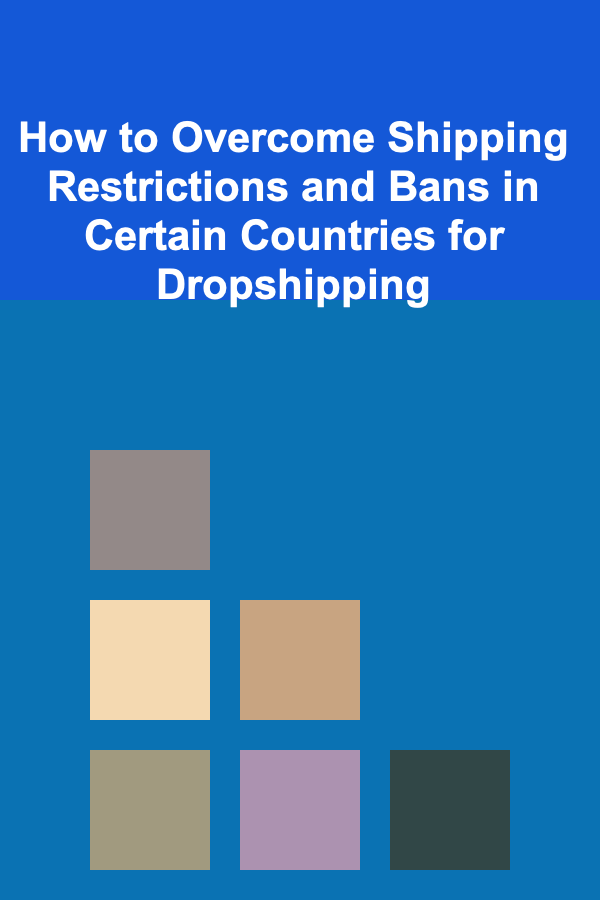
How to Overcome Shipping Restrictions and Bans in Certain Countries for Dropshipping
ebook include PDF & Audio bundle (Micro Guide)
$12.99$5.99
Limited Time Offer! Order within the next:

Dropshipping has become a popular business model for entrepreneurs looking to enter the world of e-commerce. However, one of the challenges that dropshipping businesses face is navigating shipping restrictions and bans in certain countries. These barriers can hinder the ability to scale a business and prevent access to profitable markets. In this actionable guide, we'll explore how you can overcome these restrictions and ensure that your dropshipping business runs smoothly across borders.
Understand the Source of Shipping Restrictions
Before trying to overcome shipping restrictions, it's essential to understand the various reasons why certain countries have these limitations in place. Shipping restrictions and bans can arise from:
- Legal Regulations: Some countries have strict import laws that regulate what goods can enter the country. This could be due to safety concerns, political reasons, or national security issues.
- Customs Issues: High tariffs, taxes, and customs duties can make it difficult or expensive to ship products to certain countries. Additionally, complex customs procedures may result in delayed or failed shipments.
- Shipping Carrier Limitations: Shipping companies like UPS, FedEx, or DHL may not service certain regions, or their costs may be prohibitive for dropshipping businesses.
- Product-Specific Bans: Some products, such as electronics, cosmetics, or health supplements, may be banned or regulated heavily in specific regions due to safety or quality concerns.
- Logistical Challenges: Remote or politically unstable regions may have poor infrastructure that makes shipping impractical.
Understanding the nature of these restrictions will help you devise strategies to bypass them, adapt to the environment, and continue operating without interruptions.
Research Alternative Shipping Options
One of the most straightforward ways to overcome shipping restrictions is to explore alternative shipping carriers and methods. Many dropshippers rely on a few mainstream carriers like USPS, DHL, and UPS, but there are often lesser-known carriers or shipping routes that can circumvent specific bans or limitations.
Use Regional Carriers
Some countries have domestic or regional carriers that may not be as widely known but can handle shipments to areas with restrictions. For example, in countries with strict import controls, a local carrier might have established routes and procedures that can bypass these issues. Research local delivery services and evaluate their reliability and costs.
Explore Freight Forwarding Services
Freight forwarding services can help you overcome shipping restrictions by consolidating packages and shipping them through routes that may not be accessible to regular carriers. Some freight forwarders specialize in helping e-commerce businesses navigate complex shipping requirements. They may even have experience dealing with customs clearance in restricted regions.
Utilize E-Packet and Small Packet Services
E-Packet shipping is often used in dropshipping for small packages. This service can be a good solution for overcoming shipping bans in countries where traditional methods are prohibited. It is an affordable and efficient way to ship to countries with restrictive regulations, and many suppliers in China offer e-packet as a shipping option.
Diversify Your Supplier Network
If one supplier's shipping method is restricted in a specific country, it may be worth considering other suppliers who can offer similar products but with different shipping methods or routes. You may need to work with multiple suppliers in different regions to overcome shipping limitations.
Leverage Third-Party Warehousing Solutions
When shipping products internationally, you may face significant delays or increased costs. Third-party warehousing services provide a potential solution by allowing you to store inventory in various global locations.
Use Fulfillment Centers in Target Countries
Fulfillment centers in the target countries can handle local deliveries more efficiently, bypassing the need for cross-border shipping. By partnering with fulfillment centers located in countries with fewer restrictions, you can streamline your operations and improve delivery times. Some popular third-party fulfillment services include:
- ShipBob
- Fulfillment by Amazon (FBA)
- Easyship
- Rakuten Super Logistics
These services can also help you reduce the risks associated with international shipping by localizing your inventory and offering reliable, restricted-free shipping methods.
Explore Dropshipping Automation Platforms
Some dropshipping platforms and apps, such as Oberlo , Spocket , and SaleHoo, have partnerships with fulfillment centers across the world. By using these platforms, you can leverage warehouses in countries with fewer shipping restrictions to fulfill your orders faster and at lower costs.
Adapt Your Product Selection
Another way to overcome shipping bans is by adapting your product offering to match the shipping restrictions of certain regions. Countries may have different regulations regarding specific types of products, so it's important to ensure that the products you're dropshipping comply with local rules and bans.
Avoid Restricted or Banned Products
Certain products face heavy scrutiny and often get banned in particular countries. These include electronics with specific safety certifications, medical supplies, or even beauty products with certain chemicals. You'll need to research and avoid products that may face higher levels of scrutiny in countries with shipping bans.
Source Locally-Compliant Products
Some regions are only restrictive about certain categories of products. For instance, health supplements might be restricted, while clothing or electronics may not face the same regulations. Tailor your product offering based on the local needs and laws of your target market. Research the legal requirements of each country and make sure your products are compliant to avoid shipping issues.
Focus on Niche Markets
Instead of targeting a broad audience in restricted regions, focus on niche markets where specific products may not face heavy regulations. Niche products might be overlooked by larger companies but could still find success in a smaller, dedicated market.
Establish a Strong Relationship with Your Shipping Partners
Building strong relationships with your suppliers and shipping partners can be key to overcoming shipping restrictions. Having a dedicated and experienced team that understands the intricacies of global shipping can save you a lot of hassle.
Communicate Regularly with Your Suppliers
Ensure that your suppliers are aware of the shipping restrictions in your target countries. They may have updated knowledge on which carriers are the most reliable, as well as alternative shipping methods. Suppliers with experience in international shipping are more likely to offer solutions to bypass restrictions.
Collaborate with Customs Experts
Customs clearance is a major hurdle in international shipping, and understanding each country's specific rules is crucial. Work with customs experts or use freight forwarders that specialize in helping businesses navigate customs regulations. They can help ensure your shipments arrive on time and without any issues.
Educate Your Customers
In many cases, shipping delays or issues are beyond your control, especially when dealing with restricted countries. Transparency and communication are key when navigating these challenges. Educating your customers about potential shipping delays or restrictions will help set realistic expectations and build trust.
Provide Shipping Estimates
Always provide clear and realistic shipping estimates based on the country's shipping restrictions. If there are known delays in certain regions due to customs or shipping restrictions, make this known upfront to your customers. Transparency will reduce customer frustration and improve their overall experience.
Offer Localized Payment Options
Some countries may not allow international payments or may have specific regulations regarding online payments. By offering localized payment options like PayPal, Stripe, or region-specific payment gateways, you can bypass some of these financial restrictions and increase your chances of completing a sale.
Address Returns and Refunds Policies
Shipping bans can result in delays or failures in delivering products. Ensure that your returns and refund policies are clear and customer-friendly. Having an established plan for handling lost or delayed shipments will further strengthen customer trust in your business.
Stay Updated on Changes in Shipping Regulations
Shipping restrictions can change over time due to evolving trade agreements, political climates, or local laws. Staying updated on changes in shipping regulations is essential to ensuring that your dropshipping business remains compliant and efficient.
Monitor International Trade Laws
Regularly monitor international trade news, customs updates, and changes in shipping regulations. You can sign up for newsletters or join trade groups to stay informed about the latest developments.
Join Dropshipping Communities
Online forums and dropshipping communities can be excellent sources of information when it comes to understanding the latest shipping challenges in different countries. Engaging with other entrepreneurs can provide valuable insights into overcoming regional shipping issues.
Conclusion
Shipping restrictions and bans in certain countries are a common challenge for dropshipping businesses. However, by understanding the source of these issues, exploring alternative shipping options, leveraging third-party warehousing solutions, adapting your product selection, and building strong relationships with your shipping partners, you can successfully navigate these barriers.
The key is to stay informed, be flexible, and continually adapt your strategies to meet the ever-changing landscape of international shipping. By doing so, you can ensure that your dropshipping business remains competitive and continues to thrive, even in the face of challenges.
Reading More From Our Other Websites
- [Home Security 101] How to Use Motion Detectors to Protect Your Home from Intruders
- [Home Soundproofing 101] How to Soundproof Your Garage for a More Peaceful Workspace
- [Home Staging 101] How to Use Color to Enhance Your Home Staging
- [Organization Tip 101] How to Use Color Coding for Document Management
- [Home Security 101] How to Make Your Home More Secure During the Holiday Season
- [Home Soundproofing 101] How to Soundproof an Apartment's Common Walls
- [Organization Tip 101] Top Home Improvement Tips for Creating Accessible Bathrooms
- [Home Space Saving 101] How to Use Modular Storage Systems for Flexible Space Management
- [Personal Investment 101] How to Choose the Best Investment Apps for Your Financial Goals: A Guide to Optimizing Your Portfolio
- [Toy Making Tip 101] From Block to Plaything: A Beginner's Guide to Crafting Wooden Toys

How to Keep Fishing Gear Safe from Rust and Corrosion
Read More
How to Organize Your Garage to Free Up Space for More Storage
Read More
How To Reduce Your Exposure to Outdoor Pollutants
Read More
How to Teach Language Learning Online and Grow Your Client Base
Read More
How to Build a Stronger Sense of Belonging
Read More
How To Warm Up Your Voice Before a Speech
Read MoreOther Products

How to Keep Fishing Gear Safe from Rust and Corrosion
Read More
How to Organize Your Garage to Free Up Space for More Storage
Read More
How To Reduce Your Exposure to Outdoor Pollutants
Read More
How to Teach Language Learning Online and Grow Your Client Base
Read More
How to Build a Stronger Sense of Belonging
Read More